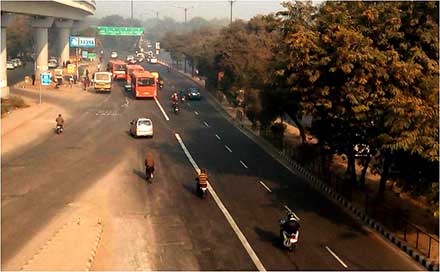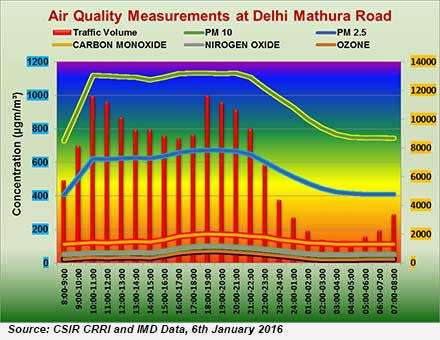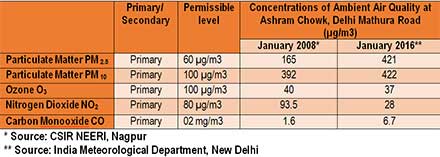CSIR-CRRI study show ways on odd even policy in Delhi- published by Dr. S. Velmurugan and Dr. Neelam J Gupta

Delhi Government is all set to return with odd even policy, but this time by publicizing the programme extensively so that maximum people can participate in the decision making process. During the 15 days of road rationing in Delhi from January 1 to January 15, 2016, one of the most tangible outcomes was the absence of congestion and gridlocks witnessed across the capital’s arterial stretches on weekdays.
In past, 15 odd cities with serious air pollution issues have successfully implemented odd-even policy. Beijing is the most often discussed example. Even in China, this policy was successfully implemented around the Olympic Games. Implementation of odd-even vehicle by Delhi's Government led to significant reduction of 15-20 % in traffic Volume across the most congested stretch in the National Capital Region (NCR); consequently resulted in significant reduction of 30 % to 50 % of travel time during the implementation of the provisions of the scheme. The results were recorded as per a traffic volume survey done before and during odd - even formula at Delhi Mathura Road, the most important and busiest road that connects Delhi to Noida (UP) and Faridabad.
Significant reduction in overall traffic volume amounting 19.4 % on odd day and 16.6 % on even day recorded on Delhi-Mathura Road during course of the study. However the reduction of cars and autos was noted by 24 % and 22 % during odd and even days respectively, whereas proportion of bus traffic registered a minor increase to the tune of 14%. Looking at Delhi’s public transport infrastructure, there weren’t enough buses and it was not exactly the kind of transport a person used to driving himself or herself to work would want to opt for. The government may incentivise car pooling as it's not just an energy efficient way to travel, but reduces air pollution also significantly.
Study conducted by CSIR-CRRI observed a vehicular growth of 7.7 % from 2011 to 2013 and 7.5 % from 2013 to 2015 on Delhi Mathura Road. Few immediate Groundbreaking ways are required to reduce traffic volume and congestion in Delhi. The global evidence suggests that the best policy is to restrict the car-use. Reducing private car usage not only requires improvements in public transit, cycling, and walking facilities, but better management of private automobile use also. Dr. S. Velmurugan, Head, Traffic Engineering and Safety Division, CSIR-CRRI said "CRRI believes that it can be achieved by enforcing stricter parking restrictions at all locations and by making people pay for the parking. This should be accompanied by lifting the restrictions on the auto-rickshaws and taxis plying in the NCR region".
An endeavour to recover a blue sky has begun and Delhi Government has taken bold steps to combat air pollution in Delhi.
 Though air pollution depends on a number of factors like weather conditions and other sources of pollution, monitoring at Delhi-Mathura Road showed a similar trend in vehicular pollution with Traffic; says Dr. Neelam J Gupta, Principal Scientist, CSIR-CRRI, New Delhi. Data showed that average level of PM2.5 particles was 421 (µg/m3), marginally less as compared to same days in previous years. Vehicular pollution is said to be the main cause for PM2.5 levels while wind-blown dust and construction dust were the factors behind PM10 pollution during this period.
Though air pollution depends on a number of factors like weather conditions and other sources of pollution, monitoring at Delhi-Mathura Road showed a similar trend in vehicular pollution with Traffic; says Dr. Neelam J Gupta, Principal Scientist, CSIR-CRRI, New Delhi. Data showed that average level of PM2.5 particles was 421 (µg/m3), marginally less as compared to same days in previous years. Vehicular pollution is said to be the main cause for PM2.5 levels while wind-blown dust and construction dust were the factors behind PM10 pollution during this period.
Air pollutants are pervasive, and are responsible for a range of adverse health and environmental effects. It is quite evident that PM2.5 has exceeded drastically with the growth of traffic in past couple of years from the permissible level of National Ambient Air Quality Standards (NAAQS).
 However, we do have an enormous public health problem at hand but now people want a permanent solution. By coaxing people out of their cars and with increase of safer and convenient public transit ridership, cities can reduce emissions and air pollution and enjoy safer and more liveable urban environments, with less time wasted in congestion.
However, we do have an enormous public health problem at hand but now people want a permanent solution. By coaxing people out of their cars and with increase of safer and convenient public transit ridership, cities can reduce emissions and air pollution and enjoy safer and more liveable urban environments, with less time wasted in congestion.








































